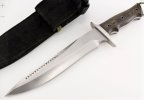- Joined
- Mar 23, 2018
- Messages
- 66
Would any of you EDC a $3500 knife for regular to hard use? Just curious as I would expect many of these “custom masterpieces” spend their lives in safes or display cases....
Well yes. That is partially what started this whole thread. A retired Green Beret was selling his 9" bladed Walter Brend he used for 23 years in SF for around $1,800, then I saw the new one for $3,500, and the first guy had stated the following:
"This knife was purchased in Late Nov 1985 and used hard until it was refinished by Walter in 1991 when I met him at a gunshow in Fayetteville. He sent it back to me and it saw light use until I retired in 2008. I think I was lucky to have gone through the Q course before they began handing out other knives, because the Brend is a better blade. This knife is on its 3rd sheath. The original sheath and two leather ones wore out and it is in an old Gerber sheath modified to ride higher. It also has a retaining band for when I jumped with it. It had pitted up on one deployment and I had Brend refinish it in the early 90s and he put his mark on the other side of the blade and you can still see an outline of the original mark. It also had black paint on the blade at one point."

Last edited:
















